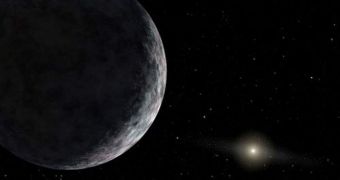In January 2005, astronomers peering into the night sky made an impressive find, a new celestial body which its discoverer first called Xena. Over the years, the finding proved critical, as it led to the creation of the dwarf planet category, and the demotion of Pluto from full-blown planet.
Earlier this month, it was revealed that this peculiar object, which is located three times farther away from the Sun than Pluto, is also larger than the other dwarf planet.
This put a dent in Pluto's status as a planet, and lead to the decision of the International Astronomical Union (IAU) to demote it to the rank of dwarf planet, similar to the space rock Ceres, which orbits the Sun in the Inner Asteroid Belt, beyond the orbit of Mars.
Even to this day, some 5 years after its discovery, the dwarf planet Eris is still considered to be the center of the debate about planetary classifications. Eris has a moon called Dysnomia.
The dwarf planet was called Eris for a reason, because this is the name of the Greek goddess of strife. Dysnomia is a Greek daemon of "lawlessness,” considered to be the daughter of Eris.
A few weeks ago, researchers demonstrated that Eris has a surface that is very similar to that of Pluto. This was an important discovery, especially in light of the fact that an experts proposed some years ago that a large number of dwarf planets exist in the Kuiper Belt.
“In some ways, what [Eris] did was really open up the entire outer solar system,” explains California Institute of Technology (Caltech) astronomer Mike Brown, the scientist who found the space body.
“It's becoming common wisdom that dwarf planets are the most common type in the solar system,” adds Southwest Research Institute (SwRI) planetary scientist Alan Stern.
Back in 2000, Stern started a new survey of the northern skies, in a bid to discover any signs of moving objects in the outer asteroid belt, that could classify as plutoids, or trans-Neptunian objects.
Until 2005, the team discovered nothing of interest. “You condition yourself to knowing what to expect,” Brown explained.
“When it [Eris] showed up on my computer screen, it took me about 30 seconds to know it was larger than Pluto. I almost fell out of my chair,” he recalls of when he found the planet.
But not everyone was happy with the new discovery and its implications. Scientists who dedicated their lives to studying Pluto did not take kindly of its demotion.
“I think most people know a planet when they see one, and I guarantee when people see the images from the Pluto system, they're going to recognize it as a planet,” explains Stern.
He is the principal investigator of the NASA New Horizons mission to Pluto, which is bound to reach the object in 5 years, Space reports.

 14 DAY TRIAL //
14 DAY TRIAL //